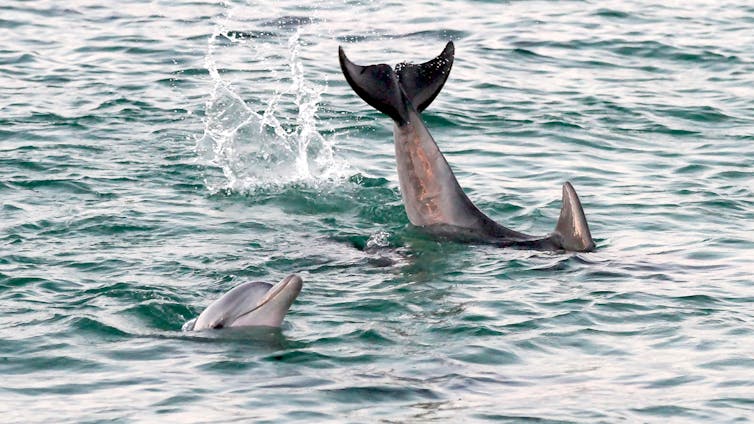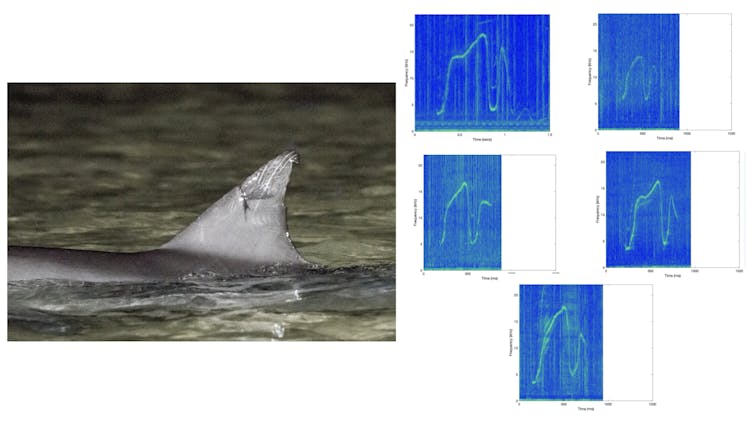Like us humans, many animals rely on social interactions to survive and thrive. As a result, effective communication between individuals is essential.
Highly social animals often have more complex communication systems. Think of a group of chimpanzees gesturing and vocalising at each other, or a family of elephants communicating through touch or low-frequency calls.
Bottlenose dolphins live in complex societies where each animal has a small number of closely connected individuals and a larger number of looser associates (not dissimilar to our own social networks). They rely heavily on interpersonal interactions to maintain a healthy social balance.
Scientists have long known that dolphins use "signature whistles" to identify themselves to others. In our recent study, we present evidence suggesting that these whistles may contain more information than just identity.

A unique but variable sound
Dolphins use various sounds, such as burst pulses and whistles, to communicate. There are two broad categories of whistles: signature whistles (distinctive whistle types that are unique to each individual) and non-signature (the rest).
Dolphins use the unique frequency patterns of their signature whistles to broadcast their identity. They develop these signals when they are young and maintain them throughout their lives.
When interacting with others, up to 30% of a dolphin's whistling may be comprised of its signature whistle. There is often some variation in the whistle versions produced by the individual animals. This led us to analyse the balance between stability and variability of the signature whistles to test if they can contain more information than just the whistler's identity.
Listening to whistles
In 2017 and 2018, our research team made repeated sound recordings of a group of Indo-Pacific bottlenose dolphins (Tursiops aduncus) at Tangalooma Island Resort near Moreton Island, off the coast of Brisbane in eastern Australia.
We collected many instances of signature whistles produced by the same animals. We also used historical data collected from the same group 15 years earlier.
We found that, while the whistles were exceptionally stable in their frequency patterns, they did vary a certain amount (this variability also remained similar across the years). This suggests that even though frequency patterns of signature whistles encode identity, they are also likely to transmit more information, such as emotional or contextual cues.

Our study group of animals was too small to draw definitive conclusions, but our findings indicated that males demonstrate more variability in their signature whistles than females. It could be linked to the differences in their social roles and the nature of their interactions with others.
We also identified a whistle much like a signature, but which was shared between several individuals. This supports recent findings that groups of dolphins may have shared distinctive whistles, along with their individual ones.
Faces that you hear
What does all this mean?
First, signature whistles are likely to be more versatile than previously thought. They may carry additional information within their frequency patterns, and possibly other structural elements.
The second lesson is that, while signature whistles are individually learned "labels" that are like human names in many ways, in terms of the information they transmit, a useful analogy may be human faces.
Humans carry identity information in our fixed facial features. At the same time, we transmit a lot of additional information, including emotional and contextual cues, through more transient facial expressions. Like signature whistles, our faces combine stability and variability in their "information package".

Making the whole world blurry
Understanding dolphin communication helps us better understand the challenges these animals face in an increasingly human-affected world.
Take noise pollution in the oceans. It's a hot topic among marine bioacoustics researchers, but rarely at the front of the general public's mind.
If we do think of it, it's probably in human terms. Living in a noisy environment for us might be annoying and stressful, but we could still do most of the things we need to do.
But for dolphins, deafening shipping noise would be the equivalent of the whole world going blurry for us. Imagine what it would be like to navigate through life, make friends, stay away from bad connections, and be socially effective (which is necessary for survival), if you can't recognise anyone's face or see their expressions.
Thinking of the dolphins' key signal, a signature whistle, as informational equivalent of our faces, may help us see (and hear) the world from a dolphin's perspective.![]()
Ekaterina Ovsyanikova, Academic, School of the Environment, The University of Queensland
This article is republished from The Conversation under a Creative Commons license. Read the original article.
